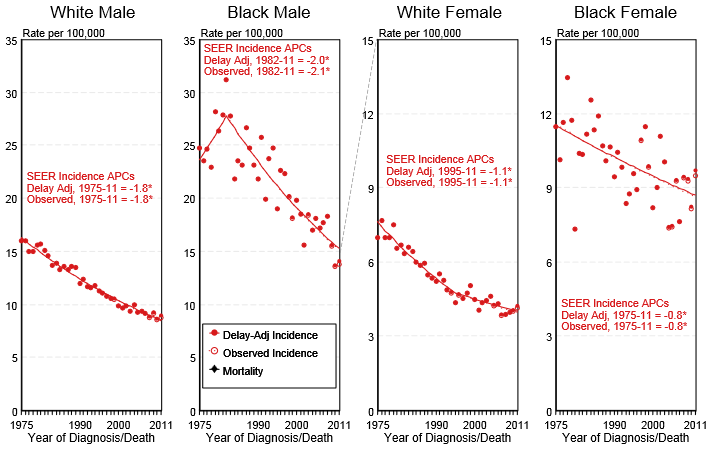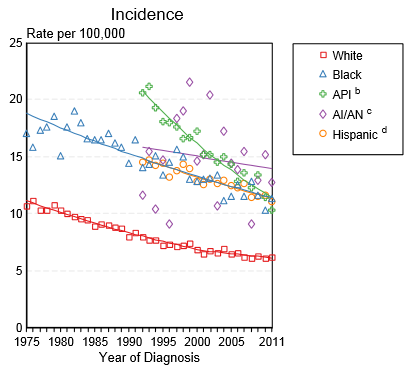Stomach cancer epidemiology and demographics
Editor-In-Chief: C. Michael Gibson, M.S., M.D. [1]; Associate Editor(s)-in-Chief: Rim Halaby, M.D. [2]
|
Stomach cancer Microchapters |
|
Diagnosis |
|---|
|
Treatment |
|
Case Studies |
|
Stomach cancer epidemiology and demographics On the Web |
|
American Roentgen Ray Society Images of Stomach cancer epidemiology and demographics |
|
Risk calculators and risk factors for Stomach cancer epidemiology and demographics |
Overview
Stomach cancer is the fifth most common cancer worldwide.[1] The incidence of gastric cancer is particularly high in Korea, Japan, Mongolia, central Asia, Eastern Europe, and parts of Central and South America.[2][3] In fact, stomach cancer is the most common type of cancer in Korea.[4] In the United States, stomach cancer represents roughly 1.3% of all new cancer cases yearly;[5] in fact, the age-adjusted prevalence of stomach cancer in is 23.5 per 100,000 in the United States in 2011.[6] Stomach cancer is two times more common in men than in women, and its incidence increases with age.[2]
Epidemiology and Demographics
Prevalence
- The incidence of gastric cancer is particularly high in Korea, Japan, Mongolia, central Asia, Eastern Europe, and parts of Central and South America.[2][3]
- stomach cancer is the most common type of cancer in Korea.[4] It is suspected several risk factors are involved including diet, gastritis, intestinal metaplasia and Helicobacter pylori infection. It is suspected several risk factors are involved including diet, gastritis, intestinal metaplasia and Helicobacter pylori infection. A Korean diet, high in salted, stewed and broiled foods, is thought to be a contributing factor. Ten percent of cases show a genetic component.[7] In Japan and other countries bracken consumption and spores are correlated to stomach cancer incidence.[8]
- In the United States, stomach cancer represents roughly 1.3% of all new cancer cases yearly.[5]
- In the United States, the age-adjusted prevalence of stomach cancer is 23.5 per 100,000 in 2011.[6]
Incidence
- The delay-adjusted incidence of stomach cancer in 2011 was estimated to be 7.27 per 100,000 persons in the United States.[6]
- In 2011, the age-adjusted incidence of stomach cancer was 7.17 per 100,000 persons in the United States.[6]
Age
- While the overall age-adjusted incidence of stomach cancer in the United States between 2007 and 2011 is 7.5 per 100,000, the age-adjusted incidence of stomach cancer by age category is:[6]
- Under 65 years: 2.9 per 100,000
- 65 and over: 38.8 per 100,000
Gender
- In the United States, the age-adjusted prevalence of stomach cancer by gender in 2011 is:[6]
- In males: 30.3 per 100,000
- In females: 18.2 per 100,000
- In the United States, the delay-adjusted incidence of stomach cancer by gender in 2011 is:[6]
- In males: 9.95 per 100,000 persons
- In females: 5.14 per 100,000 persons
- In the United States, the age-adjusted incidence of stomach cancer by gender on 2011 is:[6]
- In males: 9.82 per 100,000 persons
- In females: 5.06 per 100,000 persons
- Shown below is an image depicting the delay-adjusted incidence and observed incidence of stomach cancer by gender and race in the United States between 1975 and 2011. These graphs are adapted from SEER: The Surveillance, Epidemiology, and End Results Program of the National Cancer Institute.[6]
Race
- Shown below is a table depicting the age-adjusted prevalence of stomach cancer by race in 2011 in the United States.[6]
| All Races | White | Black | Asian/Pacific Islander | Hispanic | |
| Age-adjusted prevalence | 23.5 per 100,000 | 18.9 per 100,000 | 28.8 per 100,000 | 47.5 per 100,000 | 33.2 per 100,000 |
- Shown below is an image depicting the incidence of stomach cancer by race in the United States between 1975 and 2011.[6]
API: Asian/Pacific Islander; AI/AN: American Indian/ Alaska Native
Percent Distribution of stomach cancer by Histology
Among patients with histologically confirmed cases of stomach cancer, the percent distribution of the types of the disease between YEAR and YEAR in the United States are:[6]
- Epidermoid carcinoma: 0.9%
- Squamous cell carcinoma: 0.8%
- Adenocarcinoma: 83.7%
- Adenocarcinoma not otherwise specified: 48.3%
- Adenocarcinoma, intestinal type: 8.4%
- Adenocarcinoma, diffuse type: 3.5%
- Linitis plastica: 0.6%
- Mucinous adenocarcinoma: 1.4%
- Mucin producing adenocarcinoma: 0.5%
- Signet ring adenocarcinoma: 16.8%
- Other adenocarcinoma: 4.1%
- Other specific carcinoma: 6.3%
- Unspecified carcinoma: 2.5%
- Sarcoma and other soft tissue tumors: 0.3%
- Other specific type: 6%
- Unspecified: 0.5%
References
- ↑ Stomach cancer incidence statistics. Cancer research UK
- ↑ 2.0 2.1 2.2 Brenner H, Rothenbacher D, Arndt V (2009). "Epidemiology of stomach cancer". Methods Mol Biol. 472: 467–77. doi:10.1007/978-1-60327-492-0_23. PMID 19107449.
- ↑ 3.0 3.1 Shin A, Kim J, Park S (2011). "Gastric cancer epidemiology in Korea". J Gastric Cancer. 11 (3): 135–40. doi:10.5230/jgc.2011.11.3.135. PMC 3204471. PMID 22076217.
- ↑ 4.0 4.1 Jung KW, Park S, Kong HJ, Won YJ, Lee JY, Park EC; et al. (2011). "Cancer statistics in Korea: incidence, mortality, survival, and prevalence in 2008". Cancer Res Treat. 43 (1): 1–11. doi:10.4143/crt.2011.43.1.1. PMC 3072529. PMID 21509157.
- ↑ 5.0 5.1 SEER stat fact sheets: stomach cancer
- ↑ 6.00 6.01 6.02 6.03 6.04 6.05 6.06 6.07 6.08 6.09 6.10 6.11 Howlader N, Noone AM, Krapcho M, Garshell J, Miller D, Altekruse SF, Kosary CL, Yu M, Ruhl J, Tatalovich Z,Mariotto A, Lewis DR, Chen HS, Feuer EJ, Cronin KA (eds). SEER Cancer Statistics Review, 1975-2011, National Cancer Institute. Bethesda, MD, http://seer.cancer.gov/csr/1975_2011/, based on November 2013 SEER data submission, posted to the SEER web site, April 2014.
- ↑ AHyuk-Joon Lee, Han-Kwang Yang, Yoon-Ok Ahn, Gastric cancer in Korea Gastric Cancer, Volume 5, Number 3 / September, 2002. DOI:10.1007/s101200200031]
- ↑ Alonso-Amelot ME, Avendano M., Human Carcinogenesis and Bracken Fern: A Review of the Evidence, Curr Med Chem. 2002 Mar;9(6):675-86

